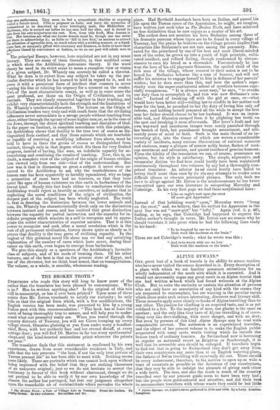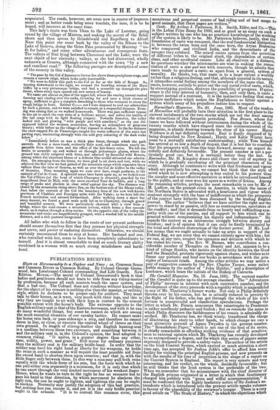ALPINE BYWAYS.*
Oren great test of a book of travels is its ability to amuse readers who have never visited the scenes described in it. Every description of a place with which we are familiar possesses attractions for us. wholly independent of the merit with which it is executed. And it would not necessarily argue any great merit in an Alpine tourist that she had written as book which had found welcome at the Alpine Club. But to smite the curiosity or sustain the attention of persons who not only have no association of any kind with the scenes they are requested to contemplate, but are wanting in the peculiar tastes which alone make such scenes interesting, discovers real literary skill. These remarks apply more closely to books of Alpine travelling than to any other. The passion for climbiug is an acquired taste, and is as yet confined to a few. To the majority of men, one glacier is the same as another; and the only idea they have of Alpine travelling is of some, thing very like deer-stalking, with more danger, and with no deer.. But even by persons of this kind Alpine Byways may be read wills considerable interest. The authoress is an experienced traveller, and the object of her present volume is to make the English public acquainted with many spots worth visiting which lie outside the beaten track of ordinary tourists. As Switzerland now is becoming as regular an autumnal resort as Brighton or Scarborough, it is well that its accessible area should be enlarged. If travellers begin. to find out that in going to Switzerland they don't get away from their own countrymen any more than at an English watering place„ the fashion of Swiss travelling will eventually die out. There should be every inducement, therefore, to the natives to open up as wide a. tract of mountain as possible to the footsteps of our countrymen,. that they may be able to indulge the pleasure of giving each other a wide berth. The inns, and also the roads in much of the country travelled over by our present guide seem to have been very bad ; but the people were good-natured and attentive, and did their best to accommodate travellers with whose wants they could be but little.
• Alpine Byways; or, Light Leaves gathered in 1860 and 1860. By a Lady. London, Longman.
acquainted. The roads, however, are even now in course of improve- ment ; and as better roads bring more tourists, the inns, it is to be hoped, will improve at the same time.
This lady's route was from Thun to the Lake of Lucerne, going round by the village of Miinen, and making the ascent of the &hill-- thorn and then across by Grindelwald and Engelberg to Altorf. Near this point she came back by the valley of the Rhone to the Lake of Geneva, doing the Gries Pass pronounced by Murrray "un- fit for ladies," and many other adventurous and courageous feats. The valleys of Sint lying between Chamouni and the Lake, were the next object of her curiosity; valleys, as she had discovered, wholly unknown at Geneva, although connected with the town "by a new and excellent road." The following passages are descriptiveof some of the scenery in this valley.
"The pass by the Col d'Anterne to Servoz lies above these precipi tons crags, and crosses a narrow ridge, which looks quite inaccessible. "We were to follow this path to the Col as far as the falls of Rouget. So, turning downwards to the right, we crossed the brawling stream of the Haut Giffre by a very picturesque bridge, and had a scramble up through the pine forest, where every turn opened out new scenes of beauty.
We came out almost ea face of the upper fall, where the roaring torrent rushed foaming and chafing over the rocks, throwing far and near a thick shower of spray, sufficient to give a complete drenching to those who ventured to cross the rough bridge in front. Neither C— nor I were disposed to cool our admiration by such a process, and we were satisfied to remain at a respectful distance. Even- ing was closing fast as we walked homewards. There was just sufficient vapour in the air to catch the rosy tints of a brilliant sunset, and soften the outline of the tall crags with its light floating drapery. Towards Samoans, the valley looked rich and glowing " with purple and with amethyst," as the sun dis- appeared behind the western mountains, leaving. an atmosphere of gorgeous beauty; while before us the village of Slit reposed in shadow. In the far distance the snow-capped Pic de Tinneverges caught the warm reflexion of the sun's last parting rays, contrasting strongly with the cold grey colouring of the dark rocks
" Immediately before us was a thick pine forest, through which the path ascends. It was a mere track, evidently little used, and sometimes nearly im- passable from fallen trees and the effect of the late heavy rains. We left the mules to scramble up, and walked on through picturesque glades, where the ground was richly carpeted with ferns, and adorned by beautiful wild flowers, among which the abundant bloom of a delicate lilac orchid attracted our admira- tion. On emerging from the forest, we were glad to sit down and rest, while we admired the fine view we had gained of the mountain range which separates these valleys from the lake of Geneva, as well as over the Col de Golese to the valley of Samoans. Then mounting again we rode over bare, rough pastures, to the summit of Col de Cour. A splendid scene here burst upon us, as we looked over the Val d'llliers (at the head of which Champrey is situated), guarded by the magnificent Dent de Midi, with the snow-crowned Tour de Salhere, and a long range of peaks and glaciers in clear relief against the sky. The distance was closed by the mountains rising above Bea, on the further side of the Rhone valley. Just below the summit of the Col the boundary lines of the now well-known provinces of Chablais and Faucigny unite with the Valais ; so we here left the French territories and entered Switzerland. After walking down a short but steep descent, we found a good mule path led on to Champrey, through grand and beautiful scenery. We were particularly charmed with a view from a bridge, where the road crosses a mountain torrent, which forms a fine cascade above, as it rushes through a deep ravine. On the opposite side of the valley the mountains and rocks are magnificently grouped, with a wooded hill in the middle distance, and a rich pastoral foreground."
All ladies who wish to follow in the route of our present authoress should assure themselves first that they possess her physical strength and nerve, and power of enduring discomfort. Otherwise, we should certainly recommend them to stay at home. Her husband and son, who travelled with her, seem to have been completely subordinate to herself. And it is almost remarkable to find so muck literary ability combined in a woman with so much strong mindedness and hardi- hood.































 Previous page
Previous page